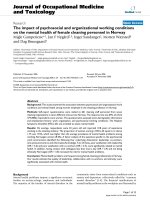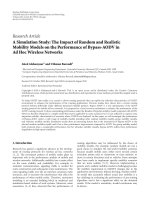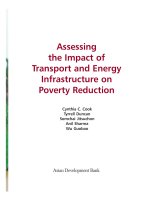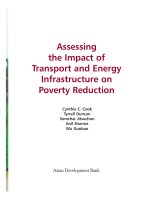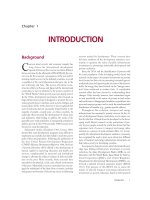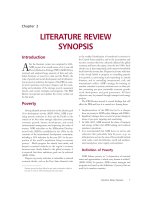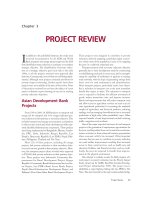The impact of personal values on attitude toward consequences of purchase and environmental commitment in green consumption
Bạn đang xem bản rút gọn của tài liệu. Xem và tải ngay bản đầy đủ của tài liệu tại đây (753.03 KB, 79 trang )
UNIVERSITY OF ECONOMICS HO CHI MINH CITY
International School of Business
----------------------------------
Tran Que Khanh
THE IMPACT OF PERSONAL VALUES
ON ATTITUDE TOWARD CONSEQUENCES OF
PURCHASE AND ENVIRONMENTAL COMMITMENT
IN GREEN CONSUMPTION
MASTER OF BUSINESS (Honours)
Ho Chi Minh City – Year 2014
UNIVERSITY OF ECONOMICS HO CHI MINH CITY
International School of Business
----------------------------------
Tran Que Khanh
THE IMPACT OF PERSONAL VALUES
ON ATTITUDE TOWARD CONSEQUENCES OF
PURCHASE AND ENVIRONMENTAL COMMITMENT
IN GREEN CONSUMPTION
ID: 22120126
MASTER OF BUSINESS (Honours)
SUPERVIOR: Dr. Le Nhat Hanh
Ho Chi Minh City – Year 2014
ACKNOWLEDGEMENT
I am forever grateful to so many individuals. Without their support, I would
have never completed this research.
I would like to express my gratitude to Dr. Le Nhat Hanh, my supervisor, for
her valuable suggestions, ideas and comments. She has always encouraged me to
finish my master program from the beginning to the end of my work.
I would like to extend my appreciation to the other members of committee for
their contributions which helped me to improve this research.
Thank you to all of people who spent their time and effort for my survey.
Last but certainly not least, I am deeply appreciative of the endless love and
good conditional support from my family to complete this work.
ABSTRACT
Facing with environmental problems all over the world, more and more people
turn their talk into walk. In other words, consumers are not only concerned but also
getting the idea of being greener. According to this, by buying the ecologically
friendly products, they want to reduce their impact of purchase on environment.
Hence, the aim of this research is to examie the impact of personal values on attitude
toward consequences of purchase and environmental commitment in green
consumption.
A convenience sampling method was employed. In total, 150 Vietnamese
consumer responses were collected and used for analysis to test the model. The results
show that people who commit with environment are collectivistic oriented; so these
consumers usually pay attention to environmental consequences of their purchasing.
On the other hand, individualistic consumers are more likely not to be environmental
commitment people because they are concern for themselves too much rather than
others, included: welfares and society.
This study provides useful information for businesses who are developing ecofriendly products which are not only good for the environment but satisfy consumer’s
personal needs also. The result of this study might attract attention of consumer
behavior researchers, as well as the firms that care about environmental commitment
and pursue the green strategy. Consumers who used to buy green products can be
considered as informants in future research in order to explore the underlying reason
why they buy the environmentally responsible products.
Key words personal values, consumer attitude, environmental commitment, green
consumption.
TABLE OF CONTENTS
Acknowledgement
Abstract
CHAPTER 1: INTRODUCTION--------------------------------------------------------- 1
1.1 Research background--------------------------------------------------------------------- 1
1.2 Research problems----------------------------------------------------------------------- 2
1.3 Research objective----------------------------------------------------------------------- 4
1.4 Research methodology and scope ---------------------------------------------------- 4
1.5 The significance of the study----------------------------------------------------------- 5
1.6 Research structure----------------------------------------------------------------------- 5
CHAPTER 2: LITERATURE REVIEW AND HYPOTHESES ------------------ 7
2.1The concept of personal values--------------------------------------------------------- 7
2.2 Value – attitude towards consequences of the purchase---------------------------- 8
2.3 Attitude toward consequences of purchase and environmental commitment--- 12
2.4 The proposal model---------------------------------------------------------------------- 13
CHAPTER 3: RESEARCH METHODOLOGY------------------------------------- 15
3.1 Research design ------------------------------------------------------------------------- 15
3.2 Sample size ------------------------------------------------------------------------------ 15
3.3 Measurement ---------------------------------------------------------------------------- 15
3.4 Research process ------------------------------------------------------------------------ 17
3.5 Data analysis method-------------------------------------------------------------------- 19
CHAPTER 4: DATA ANALYSIS AND DATA RESULTS ----------------------- 22
4.1 Sample characteristics ------------------------------------------------------------------ 22
4.2 The reliability test: The Cronbach’s alpha test -------------------------------------- 23
4.3 Exploratory factor analysis (EFA) ---------------------------------------------------- 25
4.4 Multiple regression analysis (MRA) -------------------------------------------------- 27
4.4.1 MRA: to define the impact of collectivistic values and individualistic values on
the attitude toward the individual consequences of the purchase --------------------- 28
4.4.2 MRA: to evaluate the impact of collectivistic values and individualistic values
on the attitude toward the environmental consequences of the purchase ------------ 32
4.4.3 Multiple regression analysis: to justify the influence of the attitude toward the
individual consequences of the purchase and the environmental consequences of the
purchase on environmental commitment ------------------------------------------------- 36
CHAPTER 5: DISCUSSION, CONCLUSION, MANAGERIAL
IMPLICATIONS AND LIMITATIONS ----------------------------------------------- 44
5.1 Discussion -------------------------------------------------------------------------------- 44
5.2 Conclusion ------------------------------------------------------------------------------- 46
5.3 Managerial implications ---------------------------------------------------------------- 46
5.4 Limitations and future research -------------------------------------------------------- 48
References ----------------------------------------------------------------------------------- 50
Appendix
PERSONAL VALUE-ATTITUDE-ENVIRONMENTAL COMMITMENT
CHAPTER 1: INTRODUCTION
In this chapter, the important of being green to adapt to changing natural
environment which are caused by human activities is demonstrated. The situation of
Vietnam is also mentioned in order to identify the same circumstances involved
environmental problems that any countries on over the world are currently facing.
Moreover, factors influencing consumers’ motivation are briefly presented, as well as
the relationship between them. Last one, the purpose, method, significance and
structure of this study are also introduced.
1.1 RESEARCH BACKGROUND
Natural environment is extremely important to the survival and growth of all
living on the Earth. Unluckily, environment has been deteriorated by human through
increasing utilization natural resources and worldwide consumption, because of the
rapid economic growth (Chen & Chai, 2010). It leads to many negative results. For
example, global warming, depletion of stratospheric ozone layer, pollution of rivers
and sea, light and noise pollution, acid rain and desertification, are consequences of
environmental degradation, among other things (Ramlogan, 1997). All of them are
called environmental problems which the world is currently facing.
Environmental problems have been concerned by more and more people. But
the underlying reasons why human begin to be environmental conscious are not the
same due to different personal point of view about the human-nature relationship.
According to the first perspective, human depend on nature environment. And the
relationship between human beings and natural environment is interactive. Human
activities impact on environment, and then, in turn the environment, it will reactively
affect to human being. It represents the utilitarian view. Beside, from ecologicalbalance perspectives, human, as well as water, land and etc are a part of a whole
system in which each element must be balanced with each other. It is a balanced
1
PERSONAL VALUE-ATTITUDE-ENVIRONMENTAL COMMITMENT
relationship. Although personal point of views may be different from each other,
helping the environmental problems society faces today is extremely necessary to
human and nature also. So therefore, some of consumers turn their talk into walk by
buying ecologically friendly products or products from companies which commit with
environment; because being green consumers is one of the ways which can reduce the
impact on the environment.
In addition, people have not the same personal perspective as each other
because of the differences in cognitions, as well as personal values. All of them lead
to their own behaviors. Fraj and Martinez (2006) stated, “Values are considered as the
criterion that individuals use to select and justify their actions” (p. 134). In this way,
there are many factors involved personal values that best explain consumers’
ecological behavior.
From the marketing point of view, business ethics and corporate social
responsibility (CSR) are become the awareness of society nowadays. On the other
hand, understanding psychographic variables is very useful to companies for
identifying the market segment, such as: the segment of consumers who commit with
environment in this case. It is also extremely important to facilitate business through
diverse strategies. To pioneer research into new green products is one of sample.
These new eco-friendly products are expected to be good for environment and serve
for personal needs; because it is necessary to satisfy more and more consumers, not
the ecological consumer segment only.
1.2 RESEARCH PROBLEMS
Comparing with developed countries, environmental topic in developing
countries is nearly new, and environmental problems are concerned in recent years.
Vietnam is the developing country with an economic growth rate of about 5.5 percent
and a population growth rate of about one percent annually. In addition, Vietnam is an
2
PERSONAL VALUE-ATTITUDE-ENVIRONMENTAL COMMITMENT
under-investigated transition economy (Tsang, 2005), especially in the developing
period and globalization, it is very necessity to aware of natural environment. For the
reason, environmental problems can be directly or indirectly linked not only to the
patterns of production by industries but also to the patterns of consumption and
behavior of consumers (Tsen et al., 2006). It is anticipated that if the consumers and
producers continue irresponsible consumption and production, the environment will
be worsen and worsen day by day.
More and more consumers have realized that and they have turned their
environmental concern into action (Kangun et al., 1991). And purchasing green
products is a specific action among others. Consumers express their value of
environmental protection through goods and services they purchase. However,
generally, there are two reasons which interrelated motivate green purchase, included
individual benefits which accrue directly to consumer and environmental benefits
which accrue to environment. The second reason is take account into environmental
consequences, which is at best long-term and future-oriented. But, it may in fact be
rarely realized by almost consumers. Organic foods are an example that consumers
buy because of good for their own health rather than for environment (Bonini and
Oppenheim, 2008). These consumers have a weaker green consumption value, and not
actually commitment with environment. For marketers, understanding factors driven
consumer’s green purchase is one of the key in green strategies in order to satisfy
customers and lead them being loyalty. It is also useful in predicting consumer
preference for environmentally friendly products.
According to Webster (1975), socially conscious consumer is defined as a
consumer who takes public consequences into consideration of his or her private
consumption. Likewise, consumers who concern environment will evaluate
environmental consequences associated with purchase decision. In other words, these
consumers commit to environment in consumption. And the products they buy not
3
PERSONAL VALUE-ATTITUDE-ENVIRONMENTAL COMMITMENT
4
only meet their current needs, but also are good for environment. Even they are
willing to be inconvenienced in order to take more environmentally friendly actions.
Several studies have indicated that the environment concern of individuals have
influenced their purchase behavior (Chan, 1996; Donaton and Fitzgerald, 1992; Kerr,
1990; Ottman, 1993; Schlossberg, 1992; Wall, 1995). Furthermore, a number of the
studies have considered personal values to understand what motivate people to buy
green products (Kim and Choi 2005; Kim, Choi and Rifon, 2009; Stern, Dietz, and
Kalof, 1993) through environmental beliefs (McCarty and Shrum, 2001) or
environmental attitude (Grunert and Juhl, 1995; Kim, 2011; Kim and Chung, 2011).
However, little attention has been paid to customers who have actually commit to
environment in consumption are primarily driven by separated attitude toward
products,
including
individual’s
personal
consequences
and
environmental
consequences. These consequences can be seen as two group attitude which are
affected by personal values. So, the research question is: Do consumers concern for
environment when they purchase products? In other words, do they actually commit to
environment in consumption?
1.3 RESEARCH OBJECTIVE
The purpose of this study is to investigate the impact of personal values on the
attitude toward consequences of purchase and environmental commitment in
consumption.
1.4 RESEARCH METHODOLOGY AND SCOPE
The research was conducted on consumers in Vietnam. It centralizes all gathers
and trading activities people come from different social level, as well as provinces and
town in our country.
PERSONAL VALUE-ATTITUDE-ENVIRONMENTAL COMMITMENT
This study just focused its scope on consumers who have already known about
the ecologically friendly products, involved: green components, green process and less
packing. And it is well defined at the beginning of survey.
The researcher handled the collected data and performed them by applying data
analysis tools (Microsoft Excel and SPSS). Next step, the author used Cronbach’s
alpha to test the reliability of the scale; doing exploratory factor analysis to identify
which item is belong to others and to group them into a fairy large set. After that, the
author used multiple regression analysis to check the relationship between
independent variables and dependent variables.
1.5 THE SIGNIFICANCE OF THE STUDY
After this research, it is hopeful that its founding will play an important role in
predicting environmental commitment in consumption in order to develop the suitable
strategies to encourage, as well as educate consumers to choose and buy the ecofriendly products instead of the non-responsible alternative ones; and to research &
develop more new green products which not only are friendly with environment but
satisfy consumers also.
1.6 RESEARCH STRUCTURE
This thesis included five chapters
Chapter 1: Introduction
In this chapter, the author presents the research background of the study,
research problems, research objectives and the research structure.
Chapter 2: Literature review and hypotheses
This chapter presents the fundamental theories and concepts which
invloved in. The proposal model and hypotheses are also presented in this
chapter.
5
PERSONAL VALUE-ATTITUDE-ENVIRONMENTAL COMMITMENT
Chapter 3: Research methodology
This chapter mentions about the sample and sample size; mesurement of
the constructs and data analysis method.
Chapter 4: Data analysis and data results
The author summeries the collected sample characteristics and presents
the research results after analyzing the collected data. After that, the author
gives the conclustions for the hypotheses which proposed in chapter 2 from that
result.
Chapter 5: Dicussion, conclusions, managerial implications and limitations.
This chapter dicusses about the main results, draws the conclusions and
indicates the contribution of the study in management theory, as well as in
pratice. Besides, limitations are also mentioned for future research direction.
6
PERSONAL VALUE-ATTITUDE-ENVIRONMENTAL COMMITMENT
CHAPTER 2: LITERATURE REVIEW AND HYPOTHESES
In this chapter, the author presents definition of each mentioned concept,
fundamental theories, and draws the theoretical modeling with the proposed
hypotheses.
2.1 THE CONCEPT OF PERSONAL VALUES
Personal values or individual values are considered as the frame of reference
that individuals use to select, evaluate and justify their behaviors which are ordered by
relative important/unimportant, good/bad. In other words, personal values can be
understood as “desirable goals, vary in importance, that serve as guiding principles in
people’s lives” (Schwartz, 1994, p.88). And every individual has a specific value
structure which forms the standards to lead personal behavior towards other people or
objectives (Anana and Nique, 2007).
Aspect of a value is the type of goal or motivation that it concerns, Schwartz
and Bilsky (1987, 1990) proposed that human values represent three universal
requirements of human existence:
(a) Needs of individuals, (egoistic concerns)
(b) Requisites of coordinated social interactions, (altruistic concerns)
(c) Survival and welfare needs of groups. (biospheric concerns)
Schwartz (1992) developed a universal value structure which is grouped into
four dimensions, based upon collective-individual dichotomy, included: selftranscendence, self-enhancement, conservation and openness.
7
PERSONAL VALUE-ATTITUDE-ENVIRONMENTAL COMMITMENT
2.2
VALUE
–
ATTITUDE
TOWARDS
CONSEQUENCES
8
OF
THE
PURCHASE
The value-attitude-behavior hierarchy has served as conceptual framework for
many studies. According to this, it illustrates that values influenced attitudes and in
turn, these attitudes influenced behaviors. Several researches have applied this model
to predicting a wide range of behaviors such as in a study of environmentally
responsible purchase (Follows & Jobber, 2000), in recycling behavior (McCarty &
Shrum, 1994), or in a study of natural food shopping (Homer & Kahle, 1998). Likely,
Koo et al., (2008) showed that personal values have an impact on the evaluation of
consumer towards the service before the buying decision is made. And, Fulton et al.,
(1996) predicted attitude toward hunting and fishing which was based on two wildlife
value orientations.
Collectivistic values promote the interests of other persons and the nature
world. The definition of collectivism is characterized by: “(1) emphasis on the views,
needs, and goals of the in-group rather than on the self, (2) emphasis on behavior
determined by social norms and duties rather than by pleasure or personal advantage,
(3) common beliefs that are shared with the in-group, and (4) willingness to cooperate
with in-group members” (Triandis, 1995, p. 6). In this way, according to Triandis (as
cited in McCarty & Shrum, 2001), people are more collectivistic respect to interaction
with others, give priority of group goals, emphasizes conformity and in-group
harmony.
In other words, collectivistic values reflect an active concern for the
welfare of others and desire to improve society. It covers biospheric and altruistic
value orientation (Stern et al., 1995).
Individualistic values promote own interests regardless of others’ interests and
motivate people to enhance their own personal interests. People are more
individualistic tend to give priority of personal goals over group ones (Triandis, 1989),
self-oriented (Hofstede, 1980). They emphasize individual rights over duties and
analysis cost-benefit in determining behavior (Triandis, 1995). A more specific
PERSONAL VALUE-ATTITUDE-ENVIRONMENTAL COMMITMENT
definition of individualism indicate individuals who: “(1) view themselves as
independent of collectives, (2) are primarily motivated by their own preferences,
needs, rights, and the contracts they have established with others, (3) priority to their
person goals over the goals of others, and (4) emphasize rational analysis of the
advantages and disadvantages of associating with others” (Triandis, 1995, p. 2). It is
named as egoistic value orientation (Stern et al., 1995).
Hsu et al. (2010) stated that attitude toward a specific object can be determined by
one’s expectation of object.
Environmental consequences of the purchase can be understood as
environmentally responsible attitude in consumers’ purchase. It means they have
concerned for environment whenever they buy something. According to this,
Schwepker and Cornwell (as cited in Follows and Jobber, 2000) stated that an
environmental attitudinal measurement is combined by statements which reflect
concern for the variety of environmental issues. Similarly, in the study of
understanding green purchase, Kim (2011) also mentioned that consumers’ conscious
concern for the environmental consequences related to their private consumptions lead
them to be more favorable toward the environmentally responsible products. They
have a part in protecting and helping the environment become friendlier day by day. It
seems to be long-term objective of society.
Individual consequences of the purchase can be understood as consumers are
priority concern for themselves when they purchase something. Kim (2011) discussed
about individual consequences of the purchase that likely the purchase driven by
assessment of the product’s benefits would accrue directly and immediately to the
private individual, even sacrificing additional others. They do not care about the
others too much, included environment… And consequences of their purchase belong
to individual’s personal satisfaction and serves for individual’s personal benefits, such
as how convenient for them. It is short-term benefits and often relative to the
assessment of costs. For example, although encourage to use friendly bags when
9
PERSONAL VALUE-ATTITUDE-ENVIRONMENTAL COMMITMENT
shopping in supermarket in order to prevent the nylon bags which are harm to
environment. But, it may be inconvenient for them to bring friendly bags whenever
they go to supermarket. Moreover, the cost of friendly environmental bags always
higher than the nylon ones. If consumers buy the other friendly environmental bags in
the case of forgetting bring them, they will spend amount of money instead of free for
nylon ones. Likewise, in the research of Follows and Jobber (2000), the results
showed that consumers who took a importance placed on individual consequences of
using diapers were more likely not to intent to buy cloth ones.
According to McCarty and Shrum (2001), environmentally conscious
behaviors will be influenced by basic value orientations consumers hold with respect
to their interaction with others. In other words, the different personal values result in
their own different behaviors. Specifically, individualism focus on self whereas
collectivism emphasis on group goals.
People oriented collectivistic value are tend to more concerned with the
potential impact of their actions on the society, as well as the environment. That is, a
strong underlying awareness of welfare result in a higher attention to the
environmental consequences of the products which they intent to purchase. In so
doing, a product’s environmental consequences is one of important conditions which
collectivistic consumers consider before making purchase decision. Therefore, there is
a positive relationship between collectivistic values and attitude toward the
environmental consequences of the purchase. This relationship has supported in many
studies. Thøgerson and Grunert-Beckmann’s (1997) in a study of recycling and waste
prevention found that altruistic value (collectivistic value) has a positive relationship
with beliefs about the beneficial consequences (environmental consequences). Beside,
in study of the recycling of solid wastes, McCarty and Shrum (1994) indicated that
collectivistic value has positive relationship with importance of recycling
(environment consequences). It is hypothesized that:
10
PERSONAL VALUE-ATTITUDE-ENVIRONMENTAL COMMITMENT
Hypothesis 1: Collectivistic values will relate positively to attitude toward the
environmental consequences of the purchase.
On the other hand, collectivistic people give priority of group over personal
ones. They always take account environment into their actions. Furthermore, they are
also willing to be inconvenienced in order to help environment be greener and
friendlier. For example, collectivistic consumers prefer to buy green products rather
than alternative ones, although the eco-friendly products’ prices are higher. Or when
shopping in the supermarket, they are very please to take the reused environmentally
friendly bags, instead of using the non-responsible ones which are provided for free. It
is consistent with the recycling and waste prevention study (Thøgerson and GrunertBeckmann’s, 1997). The finding indicated that altruistic value (collectivistic value)
has a negative relationship with beliefs about cost consequences (individual
consequences). So, the hypothesis is:
Hypothesis 2: Collectivistic values will relate negatively to attitude toward the
individual consequences of the purchase.
In contrast, the characteristics of individualism are tend to stress personal rights
(for their own) over duties (for others). That is, a strong individual benefits’
enhancement lead to a less concern for their behaviors’ impact to others. These
consumers place an importance on their own needs; so they just only concern about
what products directly bring to them, even expense of others. For instance, the ecofriendly products are clearly good for environment than the non-responsible ones.
However, the alternative products are usually chosen by individualistic consumers due
to lower price; so as that they can save amount of money at the present for their own.
They do not care about the potential environmental impact when consuming the nonresponsible alternative products. Likewise, in the study of solid wastes’ recycling,
McCarty and Shrum (1994) determinate that individualistic value was positively
related to inconvenience of recycling (individual consequences). Given these
diversifying results, it is hypothesized that:
11
PERSONAL VALUE-ATTITUDE-ENVIRONMENTAL COMMITMENT
12
Hypothesis 3: Individualistic values will relate positively to attitude toward the
individual consequences of the purchase.
Hypothesis 4: Individualistic values will relate negatively to attitude toward
the environmental consequences of the purchase.
2.3
ATTITUDE
TOWARD
CONSEQUENCES
OF
PURCHASE
AND
ENVIRONMENTAL COMMITMENT
Environmental commitment (in green products version) or engaging in green
products can be understood as a promise to be loyal to green products. Commitment is
similar to loyalty (Hennig et al., 2004). According to Gounaris and Stathakopoulos
(2004), the attitudinal approve which is one of three primary different perspectives of
loyalty is based on psychological commitment, purchase intention, and word-ofmouth recommendations. In addition, a distinct difference between commitment and
loyalty is that loyalty emphasizes on past actions (Bowen and Chen, 2001; Zins, 2001)
through satisfaction, whereas commitment indicates on future ones.
On the other hand, according to Oliver (1980), customer satisfaction was
established when post purchase expectations match with actual performance. In other
words, to satisfy customers is the same as to meet their expectations. And, Namkung
and Jang (2007) showed the significant impact of customer satisfaction on
commitment, including revisit, recommendation, and positive word-of-mouth.
Moreover, Pura (2005) found that customer-perceived value significantly influences
commitment through customer satisfaction. But there has the conflict between
customer-perceived value from the environmental consequence of purchase and
individual personal’s benefits when consumer purchases environmentally responsible
products. For example, when using friendly reusable bags and refillable containers,
the environmental consequences are reductions in amount of raw materials used and
garbage generated. However, there are individual consequences, such as the
PERSONAL VALUE-ATTITUDE-ENVIRONMENTAL COMMITMENT
13
inconvenience of bringing a bag or container to the store. That may be significant
enough to override the importance placed on the environmental consequences. As a
result, consumers may be purchase non-responsible products if the responsible ones
are affect an individual’s personal satisfaction. It is negative consequences of
environmentally responsible behavior. And they are not called be an environmental
commitment person. In addition, there are many studies in investigating recycling
behavior indicated that an increase in perceived inconvenience or personal effort led
to the reduction of recycling intention (Dahab et al., 1995) and recycling behavior
(Kok and Siero, 1985; McCarty and Shrum, 1994; Thøgerson and Grunert-Beckmann,
1997). Thus, it is hypothesized that:
Hypothesis 5: Individual consequences of the purchase negatively affect to
environmental commitment.
Hypothesis 6: Environmental consequences of the purchase positively affect to
environmental commitment.
2.4 THE PROPOSAL MODEL
Behavior
Attitude toward
Personal values
H3 +
Individualistic values
H4 -
Individual consequences
of purchase
H5 -
Environmental
commitment
H2 -
Collectivistic values
H1 +
Environmental consequences
of purchase
Figure 2.1: The proposal model
H6 +
PERSONAL VALUE-ATTITUDE-ENVIRONMENTAL COMMITMENT
14
H1. Collectivistic values will relate positively to attitude toward the
environmental consequences of the purchase.
H2. Collectivistic values will relate negatively to attitude toward the individual
consequences of the purchase.
H3. Individualistic values will relate positively to attitude toward the individual
consequences of the purchase.
H4. Individualistic values will relate negatively to attitude toward the
environmental consequences of the purchase.
H5:
Individual
consequences
of
the
purchase
negatively affect
to
environmental commitment.
H6: Environmental consequences of the purchase positively affect to
environmental commitment.
Summary
This chapter mentions about definition of each concept in the model, as well as
the theoretical background which involved in. From previous literature, consumers’
attitude toward consequences of their purchase, which includes environmental
consequences of purchase and individual consequences of purchase, is impacted by
two main personal values: collectivistic values and individualistic values. And in turn,
environmental commitment is influenced by attitude toward environmental individual
consequences of purchase. To sum up, there are six hypotheses in this research.
PERSONAL VALUE-ATTITUDE-ENVIRONMENTAL COMMITMENT
CHAPTER 3: RESEARCH METHODOLOGY
The ways to find the answer for research question are mentioned in this
chapter, included: research design, sample and sample size, measurement, data
analysis method.
3.1 RESEARCH DESIGN
To dress a research design, the kind of model and measures of the constructs
were considered in order to make sure they were suitable. The focus of this research
was examining the impact of personal values on attitude toward consequences of
purchase and environmental commitment in green consumption. The operation model
was presented in Chapter 2. This research used primary data which was collected by
using convenience sampling method with a survey questionnaire. And informants
were customers in Vietnam.
3.2 SAMPLE SIZE
In this study, the model includes 5 factors with 19 items, so that the minimum
sample size should be 19*5 = 95 observations. And the researcher collected 150
observations.
3.3 MEASUREMENT
Based on the literature, the researcher set up the survey, using scales that were
already validated in previous studies. All these scales, which were translated into
Vietnamese using a translated and back translated procedure, used a five-point Likert
scale varying from 1 (completely disagree) to 5 (completely agree).
15
PERSONAL VALUE-ATTITUDE-ENVIRONMENTAL COMMITMENT
Personal values comprised two environmental value orientations: collectivistic
values (CV) and individualistic value (IV). The items measuring value orientations
were based on MCCarty and Shrum (2001)
CV1 I am working hard for the goal of a group, even it does not result in my
personal recognition.
CV2 I am a cooperative participant in group activities.
CV3 I am readily helping others in need of help.
CV4 I am doing what is good for most of the people in the group, even if it
means that individual will receive less.
CV5 I am sharing with others.
IV1
I am unique, different from others in many respects.
IV2
I am competitive with others.
IV3
I am working independently from others.
Consumers’ attitude toward individual consequences of the purchase (ICP)
was measured by 3 items which was adapted from scale of Follows and Jobber (2000)
ICP1 If green products do not fit my need properly, I will choose the
alternative ones.
ICP2 If green products are not convenient to use, I will choose the alternative
ones.
ICP3 If green products do not come in wide range of size, I will choose the
alternative ones.
Consumers’ attitude toward the environmental consequences of the
purchase (ECP) was measured by 4 items according scale of Winterich and Naylor
(2013).
ECP1 It is important to me that products I use do not harm the environment.
16
PERSONAL VALUE-ATTITUDE-ENVIRONMENTAL COMMITMENT
ECP2 I consider the potential environmental impact of my purchase when
making many of my decisions.
ECP3 My purchase habits are affected by my concern for the environment.
ECP4 I am willing to be inconvenienced in order to take actions that are more
environmentally friendly.
Environmental commitment (EC) is, in this study, mentioned above that
commitment indicate on future actions through expectation, whereas loyalty
emphasize on past actions through satisfaction. So, the measuring commitment scale
was adjusted from Zeithaml et al., (1996)
EC1 I would like to purchase green products in the future.
EC2 I would like recommend green products to friends or others.
EC3 I would say positive things about green products to others.
EC4 I would encourage others to buy green products.
3.4 RESEARCH PROCESS
Based on literature from many previous studies, the author proposed six
hypotheses which were presented in Chapter 2. After that, the researcher drew the
proposal model indicating the relationship among personal values, consumers’ attitude
toward consequences of purchase, environmental commitment.
Next step, the preliminary scale were selected for measuring constructs, as well
as conducting main survey of questionnaire. The author adjusted the questionnaire
again in order to make it easier to understand and more suitable with Vietnam market.
After finishing the properly final questionnaire, the survey was conducted by using
convenience sample which collected from consumers in Vietnam.
The process of the quantitative research was followed these below steps:
-
Step 1: The researcher composed the questionnaire for the research:
17
PERSONAL VALUE-ATTITUDE-ENVIRONMENTAL COMMITMENT
After the author designed questionnaire in English, it was translated into
Vietnamese so as to deliver to respondents.(see in Appendix A and Appendix
B)
-
Step 2: The researcher defined the sample size of the study:
In general rule, according to Hair et al. (2010), the minimum sample is
at least 5 observations for each scale; and the sample size should be 100 or
greater. In so doing, the model in this study consists of 5 factors with 19 items,
so that the minimum sample size should be 19*5 = 95 observations.
For standard multiple regression analysis, Tabachnick and Fidell (1991)
recommended the required sample should be n > 50 + 8m (m: number of
independent variables. In this research, there are 4 independent variables.
Therefore, to run multiple regression requires the minimum sample n > 50 +
8*4 = 82 observations.
The researcher used the sample size at 150 observations which was
appropriate for both EFA and multiple regression analysis.
After that, data was conducted based on convenience sampling method.
-
Step 3: The researcher delivered the questionnaire to the respondents at
the time the research was deployed.
The hard copies of questionnaires were directly delivering to
respondents. Besides, the online questionnaire was also broadcasted by Google
docs. The link of the online survey was sent to informants via email and
facebook. After clicking on the link, the respondents could answer the survey
by keying their answers and submitting them to the researcher.
Data collection was conducted during 12 days.
-
Step 4: The research checked again the received questionnaire in order
to make sure suitable results.
18
PERSONAL VALUE-ATTITUDE-ENVIRONMENTAL COMMITMENT
Literature review
Preliminary Scale
Quantitative research
-
Compose questionnaire
Define sample size
Delivery questionnaire and collect data
Data cleaning
Encode and input the data set
Data analysis
-
Cronbach’s alpha
EFA
Multiple Regression Analysis
Writing the report
Figure 3.1: The research process
3.5 DATA ANALYSIS METHOD
For analyzing collected data in this study, researcher used the Statistical
Package for Social Science (SPSS) software version 22.0. Moreover, for sample
description, Microsoft Excel was used besides SPSS in order to statistic the sample,
compare the results. Next steps, the reliability and validity of scales were checked by
using Cronbach’s alpha and exploratory factor analysis (EFA). After that, Multiple
Regression was used for testing the relationship between independent variables and
dependent variables as proposed hypotheses.
19
PERSONAL VALUE-ATTITUDE-ENVIRONMENTAL COMMITMENT
3.5.1 Cronbach’s alpha
The acceptable value of Cronbach’s alpha for internal consistency reliability is
above or at least equal 0.6 (Nunnally & Burnstein, as cited in Nguyen, 2011). And
when the value of Cronbach’s alpha is very high (greater than 0.9), it means that there
are more items than necessary or the items are repetitious in the scale (Leech et al.,
2005).
The Corrected Item – Total Correlation also need to be considered, beside the
value of the Cronbach’s alpha. If the correlation of each specific item with the sum of
the other items in the scale is moderately high or higher than 0.4 (Leech et al., 2005),
the item is probably at least moderately correlated with the most of the other item and
will make a good component of this summated rating scale. Items with lower itemtotal correlation (negative or less than 0.3) do not fit into the scale as well. It needs to
be considered by modifying or deleting these items.
3.5.2 Exploratory factor analysis (EFA)
The purpose of EFA is to define which set of items go together as a group or
are answered similarly by respondents (Leech et al., 2005).
3.5.3 Multiple regression analysis
According to Hair et al. (2010), the purpose of multiple regression analysis is
to help the researcher to predict the level of impact of independent variable on
dependent variable.
It is necessary to test these following main assumptions in order to make sure
the multiple regression preforms exactly analysis result:
-
Assumption 1: There was the linear relationship independent variables and
dependent variable.
-
Assumption 2: The residual or error was distributed normally.
-
Assumption 3: No multicollinearity. This assumption is important because
multicollinearity could lead to misleading and/ or inaccurate results.
20



